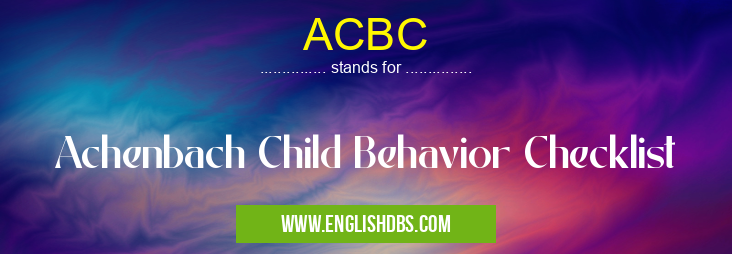What does ACBC mean in UNCLASSIFIED
ACBC: Achenbach Child Behavior Checklist

ACBC meaning in Unclassified in Miscellaneous
ACBC mostly used in an acronym Unclassified in Category Miscellaneous that means Achenbach Child Behavior Checklist
Shorthand: ACBC,
Full Form: Achenbach Child Behavior Checklist
For more information of "Achenbach Child Behavior Checklist", see the section below.
The Achenbach Child Behavior Checklist (ACBC) is a widely used instrument for assessing behavioral and emotional problems in children and adolescents. It is a standardized, empirically derived questionnaire that provides comprehensive information about a child's behavior in a variety of settings.
ACBC Meaning
The ACBC derives its name from its creator, Dr. Thomas M. Achenbach, a clinical psychologist and professor of psychiatry at the University of Vermont.
Key Characteristics of ACBC
- Comprehensive: Assesses a wide range of behavior problems, including internalizing (e.g., anxiety, depression) and externalizing (e.g., aggression, rule-breaking) symptoms.
- Standardized: Normed on large, representative samples of children and adolescents.
- Empirically Derived: Based on extensive research and validation studies, ensuring its reliability and validity.
- Informative: Provides detailed information about a child's behavior in various contexts, including home, school, and peer relationships.
ACBC Components
The ACBC consists of multiple versions tailored to different age groups:
- Child Behavior Checklist for Ages 4-18 (CBCL): Completed by parents or caregivers.
- Teacher Report Form (TRF): Completed by teachers.
- Youth Self-Report (YSR): Completed by children and adolescents ages 11-18.
Uses of ACBC
The ACBC is widely used in clinical, educational, and research settings for:
- Identifying children and adolescents with behavioral and emotional problems.
- Monitoring treatment progress and evaluating outcomes.
- Conducting research on child and adolescent development.
Essential Questions and Answers on Achenbach Child Behavior Checklist in "MISCELLANEOUS»UNFILED"
What is the Achenbach Child Behavior Checklist (ACBC)?
The ACBC is a widely used tool for assessing behavioral and emotional problems in children and adolescents. It consists of a series of questionnaires that are completed by parents, teachers, or other caregivers. The ACBC provides a comprehensive profile of the child's behavior, including internalizing problems (e.g., anxiety, depression), externalizing problems (e.g., aggression, oppositional behavior), and social skills.
How is the ACBC used?
The ACBC is used in a variety of settings, including clinical practice, research, and school settings. It can help clinicians diagnose mental health disorders, track treatment progress, and make informed treatment decisions. The ACBC can also be used to identify children and adolescents who are at risk for developing behavioral or emotional problems.
What are the benefits of using the ACBC?
The ACBC has a number of benefits, including:
- Validity: The ACBC has been shown to be a valid and reliable measure of behavioral and emotional problems in children and adolescents.
- Comprehensiveness: The ACBC provides a comprehensive profile of the child's behavior, including both internalizing and externalizing problems.
- Ease of use: The ACBC is easy to administer and score, making it a practical tool for busy clinicians and researchers.
What are the limitations of the ACBC?
The ACBC has some limitations, including:
- Subjectivity: The ACBC relies on the subjective reports of parents, teachers, or other caregivers, which can be influenced by their own biases or perceptions.
- Cultural bias: The ACBC may not be culturally sensitive, and it may not be appropriate for use with children and adolescents from diverse backgrounds.
Are there any alternative assessment tools to the ACBC?
Yes, there are a number of alternative assessment tools that can be used to assess behavioral and emotional problems in children and adolescents. Some of these tools include:
- Child Behavior Checklist for Ages 1½-5 (CBCL/1½-5)
- Teacher Report Form (TRF)
- Youth Self-Report (YSR)
- **Conners Rating Scales
Final Words: The ACBC is a valuable tool for assessing behavioral and emotional problems in children and adolescents. It provides comprehensive, standardized, and empirically derived information about a child's behavior in multiple settings. The ACBC is widely used by clinicians, educators, and researchers to identify, monitor, and treat behavioral and emotional problems in youth.
ACBC also stands for: |
|
| All stands for ACBC |
